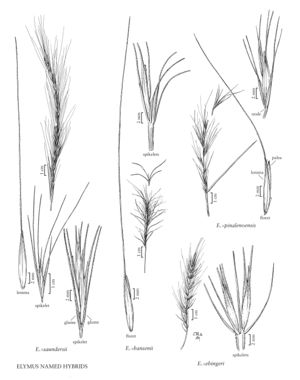Difference between revisions of "Elymus ×saundersii"
FNA>Volume Importer |
FNA>Volume Importer |
||
| Line 43: | Line 43: | ||
|publication year= | |publication year= | ||
|special status= | |special status= | ||
| − | |source xml=https://jpend@bitbucket.org/aafc-mbb/fna-data-curation.git/src/ | + | |source xml=https://jpend@bitbucket.org/aafc-mbb/fna-data-curation.git/src/f6b125a955440c0872999024f038d74684f65921/coarse_grained_fna_xml/V24/V24_484.xml |
|subfamily=Poaceae subfam. Pooideae | |subfamily=Poaceae subfam. Pooideae | ||
|tribe=Poaceae tribe Triticeae | |tribe=Poaceae tribe Triticeae | ||
Revision as of 19:15, 24 September 2019
Plants cespitose, not rhizomatous. Culms 50-80 cm, erect, glabrous or pilose. Leaves somewhat basally concentrated; sheaths retrorsely hairy; auricles to 1 mm; ligules 0.5-1 mm; blades 10-15 cm long, 4-5 mm wide, flat, becoming involute when dry, tapering to the apices. Spikes 10-25 cm long, 1-2.5 cm wide, with 1 spikelet per node; internodes 4-5 mm; disarticulation at the rachis nodes. Spikelets 10-25 mm excluding the awns, with 3-6 florets. Glumes 6-8 mm, linear-lanceolate to lanceolate, 3-5-veined, veins scabrous, apices sometimes toothed, awned, awns 8-13 mm; lemmas 10-13 mm, glabrous, smooth proximally, scabrous distally, awned, awns 20-45 mm, outcurving; anthers 1.5-2 mm, usually indehiscent.
Distribution
Colo., N.Mex., Utah, Calif., Mont., Wyo., Ariz., Idaho, Nev.
Discussion
Elymus ×saundersii comprises hybrids between E. trachycaulus (p. 321) and E. elymoides (p. 318). Such hybrids are found throughout much of the western portion of the contiguous United States, mostly in disturbed areas. The hybrids are generally sterile and, as in all hybrids involving E. elymoides or E. multisetus (p. 318), the rachises disarticulate at maturity.
Elymus ×saundersii is an Elymus named hybrid
Elymus is notorious for its ability to hybridize. Most of its interspecific hybrids are partially fertile, permitting introgression between the parents. The descriptions provided below are restricted to the named interspecific hybrids. They should be treated with caution and some skepticism; some are based solely on the type specimen, because little other reliably identified material was available. Moreover, as the descriptions of the non-hybrid species indicate, many other interspecific hybrids exist.
The parentage of all hybrids is best determined in the field. Perennial hybrids, such as those in Elymus, can persist in an area after one or both parents have died out, but the simplest assumption is that both are present. Interspecific hybrids of Elymus that have disarticulating rachises presumably have E. elymoides or E. multisetus as one of their parents.
Selected References
None.
